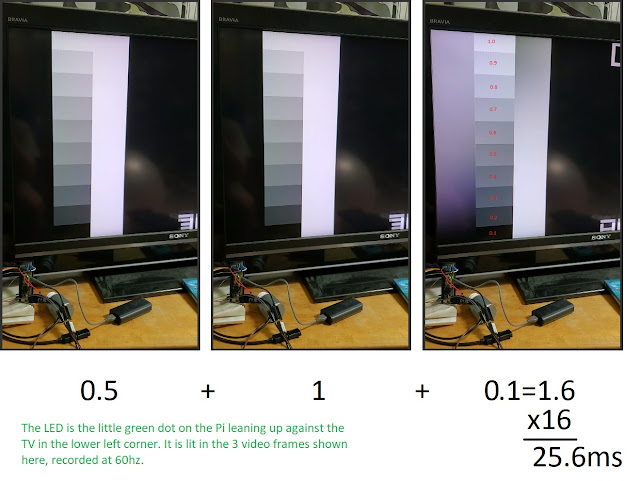Vizio E261VA review: input lag, deinterlacing and upscaling using the piLagTesterPRO
This 720p TV from 2012 offers bob deinterlacing as a togglable option for better than average 480i performance, and it's 480i/p upscaling is excellent, but otherwise it's not a great TV.
Image quality
I attempted to adjust the set to minimize cropping and aliasing, and these were the best results.
| resolution | aliasing | cropping (side, top) |
| 480p/i | very little | 20, 15 |
| 720p | some | 30,20 |
| 960p | very little | none |
| 1360x768 | zero | none |
480i/p is upscaled very nicely, with just a little aliasing. 960p is also upscaled quite well with even a little less aliasing. And at the panel native resolution, 1360x768, every pixel is shown perfectly. 720p is actually the worst, with more aliasing and cropping than any other mode, though it's very usable.
The display has 2 HDMI, VGA, and 1 yPbPr input. I only tested HDMI.
Input Lag
I used a piLagTesterPRO to measure input lag. This device sends a frame of video over HDMI and measures how long it takes to display it. This display does not have a game mode; just a game 'color' preset that does not impact lag at all. It does have a separate "fast response mode" which seems to reduce total lag by about 3ms, and also enables bob deinterlacing I toggled all other display quality settings and did not see a consistent effect on lag, however the tests reported are with every "enhancement" set to off, in game mode, with fast response enabled.
It's maximum refresh rate for TV modes is 60hz; if you switch it to computer modes it can accept a 75hz signal at sub-native resolutions. This does not improve lag, however, as the TV continues to draw at 60hz, and just drops all the extra frames.
Input Lag Test Results
I report two kinds of values. 1st response measures how long it takes for the TV to start responding (I use a 5% change in display brightness). This overly optimistic value doesn't tell how long it takes to see anything useful, but matches what other reviewers call input lag. full response is a more realistic measure of lag, and requires the display to reach 80% of full brightness. This combines both input lag and response time, and is closer to what you would actually experience in a game.
This TV's response is very consistent across modes, with the 1st response at about 20ms, even in 480i. This is because the TV uses bob deinterlacing (at least when you enable "fast response" in the menus. Not everybody loves the flicker that bob deinterlacing causes, but I find that I quickly stop noticing it, and it's great that you can get this very fast mode without having to buy an expensive OSSC. The only remaining reason to use an OSSC with this set is if you want scan lines, which can make 480i content look a little sharper.
Interestingly the results for 1360x768, the native resolution of the panel, are not particularly faster than any other resolution. Apparently upscaling is a free image transformation by this era of TV hardware.
Unfortunately, this TV has a serious problem with it's response time. Every pixel change comes in two steps; first the TV goes half the distance to the final value pretty quickly (about 12ms) and then it repeats this process again after a short pause. Thus the total response time is about 25ms-30ms, and there's more than the average amount of visible ghosting behind moving objects. This design choice might allow them to claim an extra fast response time (their manual says 5ms!) because it does start responding very quickly. But since the full response is both slow, and oddly multi-step, the overall effect is poor. It's a real shame since the fast deinterlacing and the great upscaling would otherwise make this an excellent retro TV.
Results compared to other displays
To allow quick comparison between many displays I've summarized the results
across all the displays I've personally tested with the piLagTester Pro. Min
lag is the time to the first response, measured where the screen starts
drawing (typically, the top); real lag is the time to the full response,
measured where drawing finishes (usually the screen bottom), i.e. input lag +
scan out + response time. Numbers in red denote average values that can vary by
up to 8ms between power cycles.
This list is sorted by each display's 480i real lag, to give this TV its best
chance to shine:
And indeed, it does pretty well by this measure. Even with its very slow response time, its low input lag and no-lag deinterlacing means that it's near the top of my list, with only 5 TVs and several computer monitors doing better. And recall that it does a very good job of upscaling 480i. Even with the poor response time, this is a decent TV for retro gaming.
But even though its ranking is high, the next 10 sets on the list are only 1-5ms slower, and all have a much better response time, which means that motion would look smoother. So I'd choose one of those over this one, especially if I wanted to play any non 480i content where the fast deinterlacing advantage disappears.
Other models
I tested the E261VA, which is the 26" version. There appears to be two other versions: based similarities in their names, and a shared manual, I suspect that the E221VA and E191VA would perform similarly, just with smaller pixels. However, I've made no efforts to check if their specs exactly match the E261VAso that's only a quick guess. Indeed, the E221VA is actually a 1080p display which hints at some internal differences - though this set shows no sign of slowing down with up scaling (or downscaling).




Comments